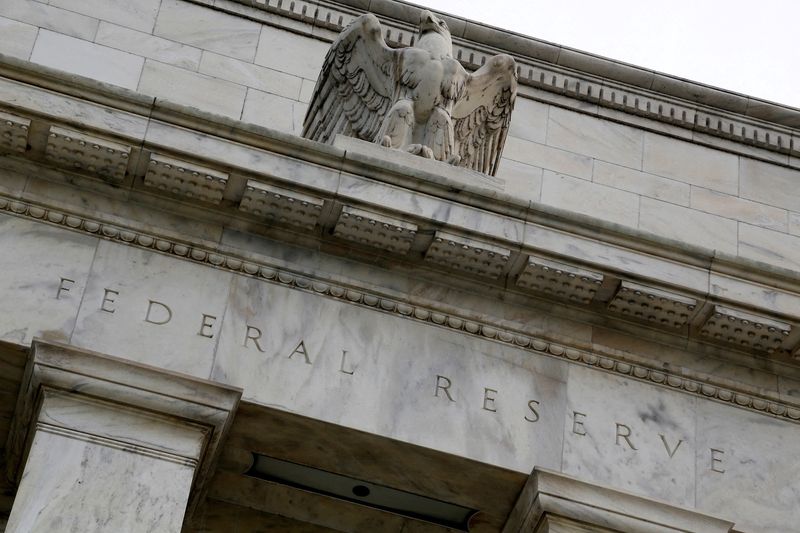By Howard Schneider and Ann Saphir
DALLAS (Reuters) - The "golden path" some Federal Reserve officials see leading to lower inflation without high unemployment may, like the pot of gold at the end of a rainbow, prove hard to find as they navigate a world of fast-adjusting markets and a new Middle East war.
U.S. central bank policymakers at this week's National Association for Business Economics (NABE) annual meeting in Dallas said they still believe they can find a monetary policy setting that lowers inflation to their 2% target without requiring a recession to create enough "slack" in the economy to do so.
But they and other economists in attendance also noted the risks on the horizon, some of which could slow activity beyond the Fed's control, and others that could keep inflation higher and force the central bank to restrain the economy more than expected. In both cases the outcome would push the Fed from that "golden path" onto a far more familiar one: An economy buckling as borrowing costs rise and confidence wanes.
"I don't think it is unavoidable" that joblessness will have to rise significantly for inflation to return to target, Dallas Fed President Lorie Logan said on Monday. "I think there is a possible path there. But the most important thing is that we stay focused on restoring price stability, and I think that will require some rebalancing in the labor market."
Fed Vice Chair Philip Jefferson, also speaking at the NABE event on Monday, said he was happy to see employment continue to expand, as long as it was "orderly and consistent" with 2% inflation.
"Employment growth in and of itself is a good thing," he said. "We just want this process in the labor market to be orderly and consistent with the kind of economy that is growing over time and is not inflationary."
Minutes of the Fed's Sept. 19-20 meeting, which are due to be released at 2 p.m. EDT (1800 GMT) on Wednesday, may shed light on the risks Fed officials see to the "soft landing" many feel is coming into view at the end of the "golden path," the term coined by Chicago Fed President Austan Goolsbee in July.
BEYOND THEIR CONTROL
Since inflation began to spike in 2021, policymakers have differed over just how much of a blow to employment would be needed to tame the pace of price increases. Some said it might require recessionary levels of layoffs; others argued the coronavirus pandemic had so skewed labor supply and demand that it could occur without large job losses.
While data and events seemed this summer to be moving in favor of the Fed's optimists, with the pace of price rises and hiring both slowing and a rush of workers into the job market helping as well, recent events showed how much remains beyond the Fed's control.
The U.S. government on Friday released a jobs report that showed employers continued in September to hire at an arguably unsustainable pace, adding 336,000 positions or roughly triple what's needed for the labor market to tread water. That was a blow to the Fed's hopes that its aggressive rate hikes since March 2022 would have had more impact on labor markets by now.
At the same time, investors have been bidding up yields on U.S. Treasury bonds in what amounts to a market-driven tightening of financial conditions beyond what the central bank itself has instigated.
That will have unpredictable effects, on a potentially global scale, and has caught the attention of Fed policymakers who say it will have to be accounted for in determining policy.
Jefferson, for example, said he has become wary about the degree to which sustained high market rates of interest will bite as more companies and households have to refinance loans taken out when rates were low: A credit-driven hammer still waiting to drop.
WAR
The outbreak of a war between Palestinian militants and Israel, meanwhile, could upend global energy markets in ways that could at least delay if not reverse the progress made on inflation.
The immediate market fallout from the violence has been muted so far. Crude oil prices on Tuesday were up about 4% from Friday, before the surprise attacks by the Palestinian Islamist group Hamas on Israel. In a sign of the mixed signals the Fed must process, U.S. Treasury yields dropped, as they often do at times of international tension given their still-perceived standing as a risk-free investment.
But at best the picture has gotten cloudier, said Christina Romer, a professor at the University of California, Berkeley, and a former head of the White House's Council of Economic Advisers. Her look at past periods of inflation and disinflation makes her think the labor market may still need a shock for the Fed to succeed.
New consumer price index (CPI) data due on Thursday will show whether inflation continued to slow in September or if progress has stalled. The CPI climbed to 3.7% on a year-on-year basis in August, while the inflation measure used by the Fed to set its 2% target, the personal consumption expenditures price index, rose to 3.5%.
Romer said that two months ago she agreed with Goolsbee and other optimistic Fed officials that a history-defying "soft landing" appeared to be developing.

But "the numbers that have been coming out recently just have been making me nervous that it is going to be harder than we thought to get down" to 2% inflation, she said on the sidelines of the NABE meeting in Dallas.
"I think it is likely to require more action" by the Fed, Romer said. "As nice as it is to see a really strong labor market, when you are trying to get inflation down, that's not your friend."